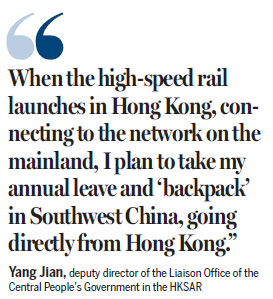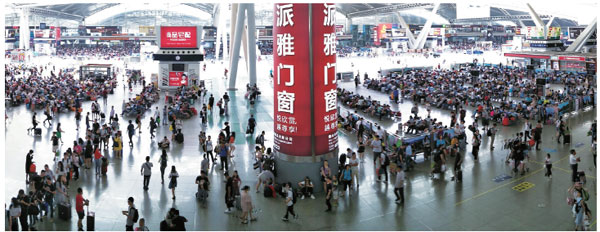Guangzhou, Nanchang - A one-day round trip
Updated: 2018-03-03 06:33
(HK Edition)
|
|||||||
The rapid development of China's world-standard high-speed railways has made mainland cities closer than ever. As Yang Jian finds out, commuting between them is 'as fast as wind'.
Early last year, I found myself torn between my official duties and my duty to an old friend.
I was trying to keep ahead of a tight work schedule, when I learned that my dear friend in Nanchang, Jiangxi province, was seriously ill, and had been taken to hospital. Friendship, beyond camaraderie and good times has its own responsibilities, like being there during tough times. But Nanchang was a long way and I was hard pressed by official duties.
Then came a happy coincidence. I got a call from another friend, who works at the China Railway Guangzhou Group.
"It's not a problem at all," my railroading friend said, after hearing about my quandary and wanting to see my friend, lying in hospital in Nanchang. "Take the high-speed train. You can make the round trip on the same day!"
He talked me out of my doubts. I booked a ticket online from Guangzhou South to Nanchang West Station, scheduled on a Saturday morning.
On Friday, I took the train out of Hong Kong, and spent the night in Guangzhou.

Saturday turned out to be a beautiful, sunny day and I was going home to Jiangxi to visit my old friend. But I was also excited because this was going to be my first ride on a high-speed train back home. I stepped aboard the coach and took my seat.
The amenities on board are just about what you'd expect in the first class section of a passenger jet.
There were power points and earphone jacks at every seat, set four to a row. The seatbacks were adjustable, so you could lie right back but the seats were moveable, to that they could be rearranged in a convivial arrangement for face to face conversation or even playing cards. There was plenty of room to move around.
I had chosen first class. There's second class and a costlier business class, so I was right in the middle.
Sharp at 8 o'clock, I felt the wheels start to turn beneath me. An LED board caught my attention. I watched, fascinated by the read out showing the speed of the train 100, 150, 200, 300 kilometers per hour, as we left the city and out into the countryside. My heart was beating faster as the train swiftly accelerated.
I recalled a remark by Deng Xiaoping, after he had taken his first ride on the Japanese bullet train, Shinkansen. "It's as fast as wind," Deng had exclaimed.
Sailing into the clouds
That was so long ago, at the beginning of China's reform and opening-up in the 1980s. In those days the top speed of the Shinkansen was only 210 km/h. Things have moved fast since then. We were going close to 350 km/h. I felt like I could press a button and the train would just sail aloft into the clouds.
I settled back to look out at the amazing Chinese countryside. Fellow passengers were busy snapping pictures with their smartphones. It was going to be an amazing ride through provinces, including Guangdong and Hunan, before reaching my destination. We would be rocketing through high mountains, over meandering rivers, and alongside terraced fields. It wasn't long before I decided I had to record these amazing views. I took out my digital camera and moved up to the window.
We were going so fast, nearby objects whipped by in an indistinct blur. In photographs helped to frame the distant views enhancing the images of quaint villages, and vast expanses sometime of open fields and at other times immense forests. The great mountains of southern China towered in the background.
I had felt a little nervous tingle before boarding the train, at the thought we'd be speeding along at over 300 km/h. Suddenly, I noticed I was completely relaxed. The carriage was rock steady and it didn't feel as if we were moving at all.
I recalled a video that had gone viral not long ago. A Swedish tourist riding on a Chinese high-speed train set a coin on its edge as the train race along. The coin stood upright for over 9 minutes without moving. Viewers were amused but they were also impressed. China's high-speed train became a global internet sensation.
I decided to try my own experiment and took out a HK$5 coin from my pocket and set it on its edge on the windowsill. It stood completely still. I sat and marveled!
The smoothness of the ride made me think of a grueling ride I had taken in the United Kingdom, traveling from London to Edinburgh. The carriage wobbled so much I had motion sickness the entire length of the journey and it's a long trip over hours and hours between London and Edinburgh.
I felt quite cozy here on my way to Jiangxi. What a difference! And time seemed to have passed in the blink of an eye. At around 11:30 am came the announcement that we were arriving at Nanchang West Station. I could see the train was slowing, from the LED read out, but to my surprise I felt no sensation of changing speed. The train came to a full stop at 11:44:00 - the precise scheduled time of arrival, accurate to the second. So amazing!
I was in Nanchang for five hours, went to see my friend in the hospital, had lunch at a relative's, and visited two sites in the Honggutan New District. At 5 pm, I was back on the train heading back to Guangzhou.
The return journey was going to take a bit longer. I took a nap and when I awoke my curiosity was also awakened. I was determined to find out how China had become the world leader in recent years. I turned on my laptop and started looking for answers online.
To reach the objective of "developing new generation, 350 km/h or above, high-speed trains", the government, in 2008 summoned 10,000 experts and invited them to work on a special project. They came from 25 top universities, over 20 national key laboratories and engineering centers, 40 central research institutes and more than 500 science and technology firms.
International standards
That's how China's high-speed train technology evolved, founded on individual, intellectual property rights. That's how Chinese high-speed railways were able to set the international standard.
The country also formulated the Medium and Long-term Railway Network Plan. During the 12th Five-Year Plan (2011-15), nation-wide investment in high-speed railway construction reached 1.8 trillion yuan ($283 billion). By the end of 2016, the high-speed railway network had been extended over 29 provinces, municipalities and autonomous regions across the country. Total mileage reached 22,000 km, of track, accounting for 65 percent of all high-speed rail operations around the world.
That year, our high-speed trains carried 1.47 billion passengers, accounting for 60 percent of high-speed rail passenger traffic worldwide. China is continuing to increase its investment in the system. By 2025, there will be 38,000 km of high-speed rail track in China, forming a network of eight vertical rail lines linking north and south, and eight horizontal lines connecting east to west.
"My country, you rock!" I can't help offer the cheer raised by Chinese netizens.
It was dark when the train came to a halt at Guangzhou, at 9:32 pm.
What a great trip. I had barely gotten out of the station when my friend from the China Railway Guangzhou Group texted me. "Have you arrived in Guangzhou? How was the trip?" I thought for a moment, and answered, "Fast train, comfortable seat, great view and now I'm home".
He sent me a smiling face, and encouraged me to travel more often on the high-speed train. He explained that many large- and medium-sized cities in the country have formed a thousand-kilometer living circle. Traveling by high-speed rail has become a lifestyle for many. Working class families are able to visit places in other provinces over a span of one to two years, by taking several short holidays. Traveling on weekends, or for four or five days at a time, at a cost of 3,000-4,000 yuan at a time, people can rack up a lot of miles. This kind of traveler has even acquired a name, "high-speed rail backpacker".
I was inspired by his words. "When the high-speed rail launches in Hong Kong, connecting to the network on the mainland, I plan to take my annual leave and "backpack" in Southwest China, going directly from Hong Kong." I told him my plan. "I will visit the places I've been longing to see, like the Miao Village and Wanfenglin Scenic Area in Guizhou, Dali and Shangri-La in Yunnan."
A few days ago, I read in the news that the Hong Kong government signed a memorandum with the China Railway Corporation. The Hong Kong section of the Guangzhou-Shenzhen-Hong Kong Express Rail Link is expected to begin operations in the third quarter of this year.
Every day, 127 pairs of trains will be running. Of those, 13 pairs will run directly to 14 mainland cities including Beijing, Shanghai, Guiyang, Kunming, Fuzhou and Xiamen. My "backpack" plan is now around the corner.
The author is deputy director of the Liaison Office of the Central People's Government in the Hong Kong Special Administrative Region.
The article was translated by Carrie Qiu, edited by Luis Liu and Robert Ireland.
|
The vast high-speed rail network on the mainland now enables commuters to travel from Guangzhou, Guangdong province, to Nanchang, Jiangxi province, in a matter of just three-and-a-half hours.Photos provided to China Daily |

|
Guangzhou South Station, Guangdong province, is one of the busiest in the mainland’s high-speed railway network. |
(HK Edition 03/03/2018 page6)

